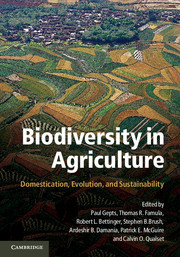Book contents
- Frontmatter
- Contents
- Tables
- Figures
- Foreword
- Contributors
- Acknowledgments
- Introduction: The Domestication of Plants and Animals: Ten Unanswered Questions
- 1 The Local Origins of Domestication
- Section I Early Steps in Agricultural Domestication
- Section II Domestication of Animals and Impacts on Humans
- Section III Issues in Plant Domestication
- Section IV Traditional Management of Biodiversity
- Section V Uses of Biodiversity and New and Future Domestications
- Index
Section I - Early Steps in Agricultural Domestication
Published online by Cambridge University Press: 05 June 2012
- Frontmatter
- Contents
- Tables
- Figures
- Foreword
- Contributors
- Acknowledgments
- Introduction: The Domestication of Plants and Animals: Ten Unanswered Questions
- 1 The Local Origins of Domestication
- Section I Early Steps in Agricultural Domestication
- Section II Domestication of Animals and Impacts on Humans
- Section III Issues in Plant Domestication
- Section IV Traditional Management of Biodiversity
- Section V Uses of Biodiversity and New and Future Domestications
- Index
Summary
Early Steps in Agricultural Domestication
This part of our volume is about major processes governing the origin and dispersal of agriculture. The contributors are in accord on many issues, in particular that there is no clear break between hunting and gathering and agriculture, the latter arising from practices that develop naturally as hunting and gathering intensifies. David R. Harris (Chapter 2), who develops this argument most broadly via a global survey of hunter–gatherer plant and animal management and manipulation, concludes that the forager-to-farmer trajectory is essentially one of increasing geographical reliance on fewer species. Much more detailed treatments of hunter–gatherer intensification and its connection to agriculture in specific regions are presented by George Willcox (Chapter 4), Ofer Bar-Yosef (Chapter 3), and M. Kat Anderson and Eric Wohlgemuth (Chapter 8). Particularly striking here is the contrast between the richly documented accounts of plant use and manipulation in aboriginal California and meager archaeological evidence for what must have been equally intensive plant adaptation ultimately leading to agriculture in the Levant. In a nutshell, we know a good deal more about the details of intensive plant use in California, where agriculture did not develop, than in the Levant, where it did. The reason for these different trajectories remains unclear, as does a means for relating one to the other. Dorian Q. Fuller (Chapter 5) offers a methodological solution to the latter via analysis of a wide range of morphometric responses to human harvesting and manipulation (e.g., changes in seed size or shape) that are expressed well before a species is considered fully domesticated (e.g., nonshattering wheat). Dolores R. Piperno (Chapter 6) adds phytolith and starch grain size and morphology to the list of characters known to change directly in response to selection. In theory, such morphometric trajectories should index selective pressures connected with plant intensification and permit meaningful comparison between the “proto-agricultural” California and the agricultural Levant. Anderson and Wohlgemuth present some of these data for California. The problem here is that some species are likely more responsive than others.
- Type
- Chapter
- Information
- Biodiversity in AgricultureDomestication, Evolution, and Sustainability, pp. 19 - 20Publisher: Cambridge University PressPrint publication year: 2012



